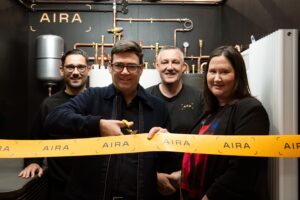Interview with Emma Bridge, Community Energy England
 Emma Bridge is chief executive of Community Energy England, a representative body for community energy organisations developing renewable energy and energy efficiency projects
Emma Bridge is chief executive of Community Energy England, a representative body for community energy organisations developing renewable energy and energy efficiency projects
Emma joined Community Energy England (CEE) as its chief executive in January 2015. Prior to joining CEE, Emma was the general manager of Sheffield Renewables, a community renewable energy group that installs solar PV on community buildings. In parallel to this she worked on two EU projects looking at renewable energy and green urban systems. She has also worked for both local and regional government on sustainable development policy.
During 2013-14, a group of representatives from networks that support grassroots action around community energy got together and the idea of a membership body quickly developed to create a stronger, collective voice.
‘It was agreed that a strong voice was needed for the sector that could make the case for change and help to create clarity for new entrants by linking, signposting and filling gaps,’ explains Emma. This led to the formation of CEE in 2014.
Today, it has 200 member organisations and acts as a representative body for community energy by developing renewable energy and energy efficiency projects. It also provides a forum and voice for both experienced community groups and support new entrants.
The aim, says Emma, is to ‘create the conditions within which the community energy sector can rapidly grow’ so that community energy projects ‘become a normal part of the work of local communities and the organisations that support them’.
The world of renewable energy continues to get caught in the tossing and turning of government policy and in order to create this rapid growth ‘the community energy sector will need to adapt to new forms of funding and engage proactively with the energy market and traditional energy sector partners, whilst still holding true to the core principles that define community action,’ she says.
That means working with the wider community energy sector, including commercial and public sector partners and service providers, and promoting the benefits that community energy can bring to the energy market and well as to a local area.
But since the general election there have been significant changes in policy direction and it’s had an impact on community energy, says Emma.
‘There has been a myriad of policy and regulatory changes affecting community energy organisations since the general election, from how a community energy organisation is registered to planning to tax reliefs to subsidies.’
In a sector often involving small, inexperienced groups, the new rules and regulations and small print bring challenges. ‘Almost every aspect of community energy activity has been hit,’ says Emma. ‘This instability and uncertainty has had a huge impact on the sector.
‘The last year has seen a huge growth in community energy because groups had to rush to register projects before tax relief and feed-in tariffs changed. That lead of projects is coming to an end now and so you will see a huge drop in new community energy projects over the next 12 months.’
That means what might have worked financially before probably won’t anymore. ‘The frequency and volume of changes of over the previous 18 months has meant most groups are only now getting chance to look at how new projects can work.’ Ever-changing policy creates a minefield of risk and less reward so that projects take longer to achieve a payback and the surpluses just aren’t there for reinvestment.
Emma believes it’s too early to say what impact the abolition of government departments like DECC will have, but adds: ‘Hopefully the mainstreaming of energy within industrial and business strategy will be a positive thing as for too long now energy has been seen a standalone issue.
‘The role that community energy can play in strengthening civil society is being considered by the Department for Culture, Media and Sport. How energy can be effectively devolved and contribute to the Northern Powerhouse within the Department for Communities and Local Government and the creation of a climate change minister role within the Department for Business, Energy and Industrial Strategy will, hopefully, mean that the climate implications of energy will not be lost.’
We shouldn’t forget the important role that communities play in energy efficiency too, a community approach would optimise impact and value for money
So, while there are squabbles over major and large-scale energy projects, what opportunities are there for community energy to fill the gap in energy supply? ‘Community energy is about far more than the generation of renewable energy; it is fundamental to nearly all positive change at a local level. The UK’s centralised energy system has resulted in people feeling disconnected from their energy choices; the relationship between energy demand, generation and supply has been obscured.’
Is energy a cause for greater civil engagement in society? Emma argues it provides a bridge between ‘community’ and ‘energy’. ‘It encourages us as individuals to take greater involvement not only over how our energy is generated but also in the process of demand reduction and energy efficiency.’
It’s not just a theory either – there is an ‘exciting pilot called Energy Local which is developing systems for communities to benefit from pooling and using their own generation and getting power cheaper at cheaper times of the day’. As Emma acknowledges, although this is still in the early stages, ‘you will start to see more and more of these types of projects taking place across the country and managing demand’.
Community energy is well established in a number of countries, providing examples the UK could learn from. Emma points to both Denmark and Germany using co-operative models, while Malawi and Australia are emerging with new ideas themselves.
CEE is keenly observing these developments and evaluating what will work best. Delegates at this year’s Community Energy Conference learnt about the growth of energy cooperatives in Germany over the past decade. The upward trend for energy cooperatives in the UK has recently started to flatten out in the face of policy changes, yet in Germany more keep emerging. ‘This demonstrates the direct impact the policy environment has on community energy start-ups,’ says Emma.
The investment the Scottish Government has made in Community Energy Malawi, an ongoing project by University of Strathclyde, could produce interesting lessons about how to embed energy into a community. In Malawi, only 9% of people have access to grid connection so the impact on lives will be huge. In the UK, where energy is often taken for granted, the lessons may be about how energy becomes part of the collective consciousness of a community.
If she was the secretary of state, the one policy change Emma says she would make is to ‘create a community feed-in tariff for the next two years to help groups to transition to new business models’.
She adds: ‘If I was being more realistic I would bring back pre-registration of feed-in tariffs for communities and schools and enlarge social investment tax relief to include community energy, as was promised by government last year.
‘To really achieve its potential, however, we need a cocktail of integrated policies that also includes a “right to invest” in renewables, prioritising community energy schemes within regulation, reinstating the exemption from climate change levy for community renewables and innovation pots to help groups test new local supply models and grid balancing.’
It’s not all about the generation and distribution of energy either, she says. ‘We shouldn’t forget the important role that communities play in energy efficiency too, a community approach would optimise impact and value for money. A refreshed community energy strategy that brings together all these facets would really demonstrate government commitment and motivate communities to respond to the opportunities that community energy can deliver.’
So, what does the next five years look like for Community Energy England? Emma’s quick to point to technical innovations including storage, new ways of supplying energy locally, better links between energy efficiency, demand management and generation and working more closely with local authorities and local enterprise partnerships.
Backed by 200 members, CEE’s key task will be to ensure community energy is recognised as an integral part of the UK’s energy strategy by government and that it’s supported accordingly.
Photo by RTPeat 















